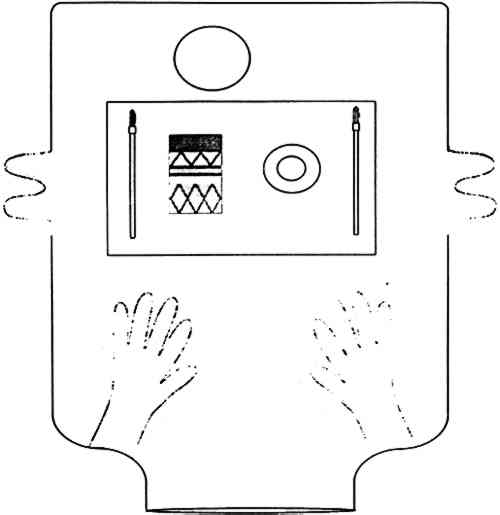CONSOLIDATION OF POROUS PAINT IN A VAPOR-SATURATED ATMOSPHEREERIC F. HANSEN, ROSA LOWINGER, & EILEEN SADOFF
5 EXPERIMENTAL5.1 MATERIALSWood blocks (kiln-dried boxwood blocks, 3 � 6 � 1 in) were obtained that did not contain resins that would solubilize and discolor the paint. The pigments chosen were ochres and kaolin because the authors were evaluating methods and materials for the consolidation of painted ethnographic wood objects (Hansen, Sadoff, and Lowinger 1990), and these particular pigments are ubiquitous on many such objects. The red ochre and the yellow ochre were supplied in mineral form and ground to a powder in mortar and pestle. The pigments were dispersed by the addition of water alone, without binder, until the paint had a consistency that allowed application by a brush (equal volumes of water and powdered pigment). A kaolin dispersion was first applied to complete hiding of the block. Then a simple geometric pattern was painted on in red and yellow ochre. The layers were allowed to dry completely (more than 72 hours) before application of consolidants. 5.2 CONSOLIDATIONSolution concentrations were 5% (w/v) PVAC AYAF in acetone, ethanol, and toluene and 5% (w/v) Acryloid B72 in acetone, toluene, xylene, and diethylbenzene. Application of the pure solvents to the painted blocks resulted in no discernible change in appearance once the solvents had dried. The solutions were applied to approximately 1-in wide areas of the sides of the blocks in two different environments: (1) open to air and (2) in a commercially available, sealable glove-bag of 3 mil polyethylene (an Atmosbag) saturated with the solvent used to dissolve the resin and placed inside a fume hood. The central area was left unconsolidated to allow visual comparison of treated and untreated areas. For each of the seven solutions, the Atmosbag was set up (fig. 8) to contain the following before sealing:
After the blocks were sealed in the Atmosbag, a period of 30 to 45 minutes passed before the consolidant was applied to the surface. The brush in use was cleaned with the appropriate solvent and the excess removed with paper towel every time the brush was removed from a painted surface and/or before treating a “fresh” area with a consolidation solution. Solutions were swirled as often as necessary to keep the concentration constant. Three methods of application were used:
Following treatment in the bag, the blocks were left 5–10 minutes, allowing the solution to penetrate. Penetration could be observed visually, as the area to which the solution was applied slowly became indistinct in comparison to the original observed darkening of the wet area. The treated block was then removed and left to air dry. Blocks were numbered for identification and comparison, and they were photographed before and after treatment. Photography proved useful because the original painted surfaces had some streaking and lines that could be misinterpreted as tide lines due to consolidation. |
